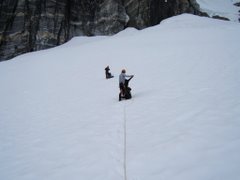 The glaciers of the dry valleys are unique, they are not experiencing the rapid retreat of their temperate and tropical counterparts. The rest of the mountain glaciers of the world have accelerated in their demise, especially it seems within the last decade (from what you can see from the photographs and moraines (rocks left by receding glaciers) left identifying glaciers used to be). What used to be snow is now falling as rain at higher and higher altitudes. This is a big concern to people reliant on glacier melt for drinking water, crops and energy. Especially areas with dry summers and little other water. (Snowpack is similarly important).
The glaciers of the dry valleys are unique, they are not experiencing the rapid retreat of their temperate and tropical counterparts. The rest of the mountain glaciers of the world have accelerated in their demise, especially it seems within the last decade (from what you can see from the photographs and moraines (rocks left by receding glaciers) left identifying glaciers used to be). What used to be snow is now falling as rain at higher and higher altitudes. This is a big concern to people reliant on glacier melt for drinking water, crops and energy. Especially areas with dry summers and little other water. (Snowpack is similarly important).Why are the dry valley glaciers an exception? Antarctica is isolated from the rest of the world with circumpolar winds and a huge ozone hole, that may or may not be healing itself. (These are among the many hypotheses being explored).
I do wonder if the channels we crawled in the last few days are indicative of change to come. I don't remember them being so incised 6 years ago. The surface is very dynamic, but it almost looks as though lower on the glacier the channels are able to penetrate deeper into the icy surface. The trapped sediment in the middle of the channel walls is at approximately the depth of the channels the first time I visited... (Could it be that the channels are 2 times deeper???)
 Above and below are shots of the Canada Glacier.
Above and below are shots of the Canada Glacier.
 While I wrote, the Frankenberg Fish went back to the Suess Glacier for a glamor shot. I realize that I am not writing this for kids (but hope the pictures entertain).
While I wrote, the Frankenberg Fish went back to the Suess Glacier for a glamor shot. I realize that I am not writing this for kids (but hope the pictures entertain).



No comments:
Post a Comment